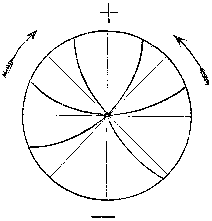TO PROFESSOR FARADAY
8 Palace Gardens Terrace,
Kensington, W., 19th Oct. 1861.
DEAR SIR—I have been lately
studying the theory
of static electric induction, and have endeavoured to form a
mechanical
conception of the part played by the particles of air, glass, or other
dielectric in the electric field, the final result of which is
the
attraction and repulsion of "charged" bodies.
The conception I have hit on
has led, when
worked out mathematically, to some very interesting results,
capable
of test-ing my theory, and exhibiting numerical relations between
optical,
electric, and electromagnetic phenomena, which I hope soon to
verify
more completely.
What I now wish to ascertain
is, whether the
measures of the capacity for electric induction of dielectric
bodies
with reference to air have been modified materially since your
estimates
of them in "Series XI." either by yourself or others.
I wish to get the numerical
value of the "electric
capacity" of various substances, especially transparent ones,
if
founded into a thin sheet of given thickness, and coated on both sides
with tinfoil. Sir W. Snow Harris has made experiments of this
kind;
but I do not know whether I can interpret them numerically.
Another question I wish to
ask is, whether
any experiments, similar to those in Series XIV., on crystalline
bodies,
have yet led to positive results. I expect that a sphere of Iceland
spar,
suspended between two oppositely electrified surfaces, would point with
its optic axis transverse to the electric force, and I expect soon to
calculate
the value of the force with which it should point. Again, I have not
yet
found any determination of the rotation of the plane of
polarization
by magnetism, in [244] which the absolute intensity of magnetism at the
place of the transparent body was given. I hope to find
such
a statement by searching in libraries, but perhaps you may be
able
to put me on the right track. My theory of electrical forces is, that
they
are called into play in insulating media by slight electric
displacements,
which put certain small portions of the medium into a state of
distortion,
which, being resisted by the elasticity of the Medium, produces an
electromotive
force. A spherical cell would, by such a displacement, be distorted
thus-—where
the curved lines represent diameters originally straight, but now
curved.

I suppose the elasticity of
the sphere to react
on the electrical matter surrounding it, and press it downwards.
From the determination by Kohlrausch and Weber of the numerical
relation
between the statical and magnetic effects of electricity, I have
determined
the elasticity of the medium in air, and assuming that it is the same
with
the luminiferous ether, I have determined the velocity of
propagation
of transverse vibrations.
The result is 193,088 miles
per second (deduced
from elec-trical and magnetic experiments). Fizean has determined
the velocity of light = 193,118 miles per second, by direct
experi-ment.
This coincidence is not
merely numerical. I
worked out the formulæ in the country before seeing Weber’s
number,
which is in millimetres, and I think we have now strong reason to
believe,
whether my theory is a fact or not, that the luminifer-ous and
the
electromagnetic medium are one.
Supposing the luminous and
the electromagnetic
phenomena to be similarly modified by the presence of gross
matter, my theory says that the inductive capacity (static) is equal to
the square of the index of refraction, divided by the coefficient
of magnetic induction (air = 1).
I have also examined the
theory of the passage
of light through a medium filled with magnetic vortices, and
find
that the rotation [245] of the plane of polarization is in the same
direction
with that of the vortices, that it varies inversely as the square of
the
wave length (as is shown by experiment), and that its amount is
pro-portional
to the diameter of the vortices.
The absolute diameter of the
magnetic vortices,
their velocity and their density, are so involved that, though as
yet
they are all unknown, the discovery of a new relation among them would
determine them all.
Such a relation might be
obtained by the observation
of a revolving electromagnet if our instruments were accurate
enough.
I have had an instrument made for this purpose, but I have not yet
overcome
the effects of terrestrial magnetism in marking the phenomena.
When I began to study
electricity mathematically
I avoided all the old traditions about forces acting at a
distance,
and after reading your papers as a first step to right thinking, I read
the others, interpreting as I went on, but never allowing myself
to explain anything by these forces. It is because I put off read-ing
about
electricity till I could do it without prejudice that I think I
have
been able to get hold of some of your ideas, such as the electrotonic
state,
action of contiguous parts, etc., and my chief object in writing to you
is to ascertain if I have got the same ideas hich led you to see your way into things, or whether I have
no right to call my notions by your names.—I remain, yours truly,
J. C. MAXWELL


